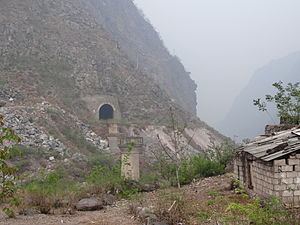Time 01:47 CST
17:47 UTC Cause mudslide Date 9 July 1981 Country China Rail line Chengdu–Kunming Railway | Type of incident bridge failure 6.5 Niri Total number of deaths 360 Injuries 146 Trains 1 | |
 | ||
Location Liziyida bridge near Ganluo County, Sichuan province Operator China Railways, Sichuan Railway Group | ||
The 1981 Chengdu-Kunming rail crash occurred on July 9, 1981, when train number 442 passed the failed Liziyida bridge near Ganluo County, Sichuan province. More than 200 had died in the accident while 146 were injured. It is the most severe train disaster in the history of the People's Republic of China.
Contents
Accident
At 1:30 am, a mudslide occurred at the Liziyida gully, a tribute of the Dadu River. The mudslide destroyed the 17-metre (56 ft) high, 110-metre (360 ft) long Liziyida bridge.
At 1:41 am, the route 442 passenger train from Geliping to Chengdu dispatched from the Niri station after passing Route 221 (another train operated on the opposite direction, from Chengdu to Jinjiang). A minute later, staffs of Niri station discovered that they had lost phone contact to the next station Wusi River station when reporting the departure of route 442.
At 1:45 am, route 442 entered the Nainaibao tunnel with a speed of 40 km/h (25 mph). After passing the tunnel curve, the driver Wang Mingru discovered that the building near the tunnel exit had collapsed and the light reflections from the rails were missing from the Liziyida bridge. Wang Mingru tried to make an emergency stop, but failed due to steep gradients of the rail before the bridge (at 14‰). As a result, two Diesel locomotives, the baggage car No. 13, the post office van No, 12, and passenger car No. 11 fell into the river. Passenger car No. 10 and No. 9 crashed into the river bank. Passenger car No. 8 derailed in the tunnel and overturned outside of the tunnel exit.
Effects
360 people were killed including 4 crew. The railway was blocked until a temporary bridge was completed on July 24. The temporary bridge was abandoned and dismantled after a new underground tunnel opened in May 1984. The Nainaibao tunnel was abandoned.
